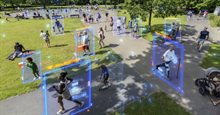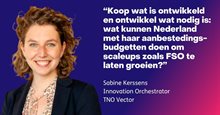The Algorithm Register as a model for Europe
’It is becoming increasingly clear where AI applications are being used in government, what developments are taking place, and where the opportunities lie. Thanks to the Algorithm Register, where governments publish information about their algorithms, anyone can see what is happening. Our country is leading the way in Europe. The register gives policymakers, politicians, journalists and businesses, among others, insight into what the government is doing with AI’, explains Elja Daae, AI and algorithms coordinator at the Ministry of the Interior and Kingdom Relations (BZK).
New quickscan
The figures on the number of AI applications come from research TNO did at the request of the Public Services Working Group of the Dutch AI Coalition, which Elja also chairs.
It is a follow-up to the 2019 and 2021 Quickscan AI in Public Services report conducted by TNO on behalf of BZK. For the application of AI in public services, TNO tried to find out where AI is being applied in the public sector, what has changed since 2021, and what lessons have been learned about AI in government in recent years.
What AI is most used for
The advent of generative AI, the language and speech technology that enables the automated creation of content as text, voice, or video, has made it much easier for individuals to engage with AI. That was an additional reason to conduct the study for the third time.
Marissa Hoekstra, researcher at TNO Vector: ‘AI is most commonly used for knowledge processing, archiving, and anonymisation, followed by inspection and enforcement. The most commonly used technology is image recognition, with speech and text recognition coming in second.’
102 out of 266 applications have actually been implemented, while 95 experiments with AI are ongoing.
Improving services with AI
‘So, the number of applications has increased rapidly, despite the tightening of our definition of AI’, says Martijn Bekking of the Dutch AI Coalition’s Public Services Working Group.
‘In 2019, there were only 75 applications. Today, there are 266 in various stages of development. The percentage of actually realised applications and experiments has also grown considerably. It shows that AI in government has matured. During my tour of government agencies, I noticed that there is really a lot going on.
There just isn’t much communication about it yet. AI has a lot of potential, from tackling fraud to improving government services. Generative AI offers numerous opportunities to make complex information more accessible, and thus better serve citizens and businesses. I think we’re going to encounter many great applications in the coming years.’
Still few complex applications
Most of the applications found within the government are fairly straightforward, we conclude at TNO. Most of the times, the goal is clear and the AI used is relatively simple. Complex applications are still few and far between.
Anne Fleur van Veenstra, scientific director of TNO Vector: ‘With the caveat that the level of complexity of an application does not tell the whole story. A simple algorithm can discriminate and a highly complex application that is well developed and validated can be a great tool. Things are not always that black and white.’
Elja Daae: ‘This could also explain the reluctance to talk about AI applications. This is often not done consciously. The government is working hard to develop and use AI in an open and transparent way, but of course, you don’t immediately want to shout from the rooftops how great your application is.’
Award for brilliant failures
Transparency and communication therefore have the full attention of the Public Services Working Group. Martijn explains: ‘Since AI is still in development, it seems safer not to communicate too much about it. That’s a shame, though. While municipalities are the frontrunners in terms of applications, they are immediately followed by dozens of examples of partnerships between government agencies. People are learning from each other, and that’s absolutely needed.
That is why we advocate more communication, even if an application is not 100% finished. Better yet, talk about what didn’t work out and why. This is the reason Elja and I present the annual award for brilliant failures in the public domain. We need to learn much more from each other.’
Successful applications in Quickscan AI report
The report cites a variety of examples of successful applications in the public domain. Examples include an anonymisation tool to shield confidential data, an algorithm that uses camera images to detect ship movements in port, one for fishery and road inspections, a virtual policy assistant to answer parliamentary questions faster and better, and a chatbot.
The report ‘Quickscan AI in Public Services III’ is now available
Download the whole report or the summary(the summary is in Dutch).






